
The present St Mary's Church is located in the centre of the small village of Clophill, between Bedford and Luton in the South Midlands of England. The new church, built in 1848, replaced the old church by order of the Church Commissioners in 1850. The old church building, formally The Church of St Mary The Virgin and known colloquially as Old St Mary's or The Old Parish Church, is at the edge of the village, and is estimated to be around 650 years old. It sits at the crest of the Greensand Ridge, offering views over the surrounding countryside. Its graveyard is a haven for wild flowers and wildlife. After the church moved to the village centre, incorporating various items from the old church building, the old building was converted for use as a mortuary chapel, but in the 1950s it fell into ruin.
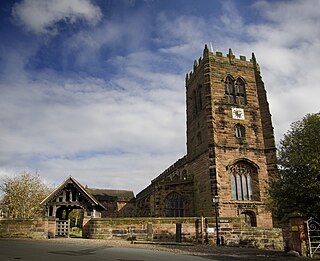
St Mary and All Saints Church is in the centre of the village of Great Budworth, Cheshire, England. It is an active Anglican parish church in the diocese of Chester, the archdeaconry of Chester and the deanery of Great Budworth. The church is recorded in the National Heritage List for England as a designated Grade I listed building. Clifton-Taylor includes it in his list of 'best' English parish churches. Richards describes it as "one of the finest examples of ecclesiastical architecture remaining in Cheshire". The authors of the Buildings of England series express the opinion that it is "one of the most satisfactory Perpendicular churches of Cheshire and its setting brings its qualities out to perfection".
Newark was a hamlet of the parish of Saint Mary the Virgin in the Soke of Peterborough in the United Kingdom. One mile and a half (2.4 km) north-east-by-east from the city centre; a portion was incorporated with the municipal borough in 1874. The remainder formed part of Peterborough Rural District from 1894 until 1926 when the city's boundaries were extended to include the civil parish of Peterborough Without.

Knotting is a small village in Bedfordshire, located near the border with Northamptonshire. Nearby places are, Sharnbrook, Podington, Odell, Melchbourne, Yielden, Newton Bromswold, Souldrop and Rushden over the border in Northamptonshire.
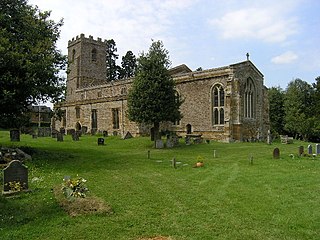
Marston St. Lawrence is a village and civil parish about 4 miles (6.4 km) northwest of Brackley in Northamptonshire. A stream flows through the village and another forms the southern boundary of the parish. The two merge as Farthinghoe Stream, a tributary of the Great Ouse. The 2001 Census recorded the parish population as 209, decreasing slightly to 202 at the 2011 Census.

The Church of St Mary and All Saints is an Anglican church in the village of Whalley, Lancashire, England. It is an active parish church in the Diocese of Blackburn. A church probably existed on the site in Anglo-Saxon times and the current building dates from the 13th century. It is recorded in the National Heritage List for England as a designated Grade I listed building.

The Church of All Saints is a Grade I listed church in Chalgrave, Bedfordshire, England. It became a listed building on 3 February 1967. The church, dedicated to All Saints, is an old structure, its consecration recorded as taking place in 1219. It features a nave, chancel, and aisles. The large square tower contains three bells. The nave has five bays. Some of the arches are Early English Period, with foliage decorated capitals, while other capitals are moulded. The register dates from the year 1539. Its fittings include two antique tombs with statues of knights in armour. The interior also features a faded wall painting featuring various saints.

Church of All Saints is a Grade I listed church in Cople, Bedfordshire, England. It became a listed building on 13 July 1964. The church, dedicated to All Saints, is constructed of sandstone and Dunstable clunch, in the Early English Period and Perpendicular styles. It contains a chancel with side chapels, nave with clerestory, aisles, south porch and a tower containing 5 bells. On the north side of the chancel, there is a marble altar tomb. The nave and chancel have been restored since 1877. The register dates from the year 1560. Its patron was Christ Church, Oxford.

Church of All Saints is a Grade I listed church in Houghton Conquest, Bedfordshire, England. It became a listed building on 23 January 1961. The parish church, dedicated to All Saints, was built during the 14th century. There are also several monuments. Houghton Conquest's rectory was united with that of Houghton-Gildable in 1637, in the archdeaconry of Bedford, and diocese of Lincoln. It was under the patronage of the Master and Fellows of St John's College, Cambridge.
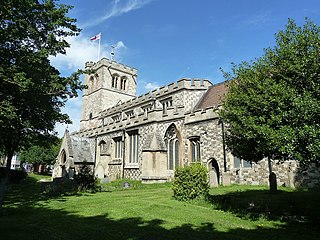
The Church of All Saints, formerly The Church of St. Michael, is a medieval building and an active Anglican parish church in Houghton Regis in the English county of Bedfordshire. It is a 13th century Grade I listed building.

Church of All Saints is a Grade II listed building located in Sawtry, a village in Huntingdonshire, Cambridgeshire, England. It became a listed building on 28 January 1958.
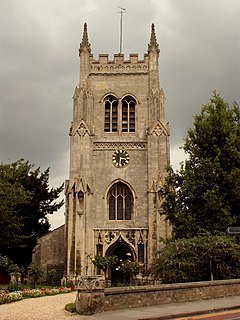
St Mary's Church is located in Huntingdon, Cambridgeshire, England. The church is said to have been the "Mother Church of Huntingdon". It occupies what is probably the original site of Huntingdon Priory of Austin Canons, founded in 1140 by Eustace de Lovetot, and seems to have been used initially as a parochial church upon the removal of the priory to the east end of town during the reign of Henry II.

St Martin of Tours is a parish church in Detling, Kent. Dedicated to Martin of Tours, the building was constructed in the 12th century with 13th and 15th-century additions and restoration carried out in the late 19th century. It is a Grade I listed building.

St Mary's Church stands on a hill in the town of Ellesmere, Shropshire, England. It is an active Anglican parish church in the deanery of Ellesmere, the archdeaconry of Salop, and the diocese of Lichfield. The church is recorded in the National Heritage List for England as a designated Grade I listed building.

All Saints Church is a Grade I listed Anglican church in Barrowby, Lincolnshire, England. The church is 2 miles (3.2 km) west from Grantham on a hillside overlooking the Vale of Belvoir, and to the south of the A52. All Saints is in the ecclesiastical parish of Barrowby and Great Gonerby.
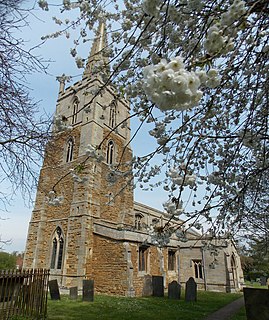
St Mary and St Peter's Church is a Grade I listed Church of England parish church dedicated to Saint Mary and Saint Peter in Harlaxton, Lincolnshire, England. The church is 2 miles (3 km) south-east from Grantham, and at the eastern edge of the Vale of Belvoir in South Kesteven.

All Saints’ Church, Bow Brickhill is a Grade II* listed parish church in the Church of England in Bow Brickhill, Buckinghamshire, to the south-east of Milton Keynes.

Church of St Mary is a 13th-century parish church in the village of Wavendon, Borough of Milton Keynes, Buckinghamshire, England. It was designated a Grade II* listed building in 1966.

St Andrew's Church is the Anglican parish church for the town of Biggleswade in Bedfordshire, England. The church is Grade II* listed and comes under the Diocese of St Albans. The church is noted for its monumental brass of John Rudying of 1481 featuring the Figure of Death.

Edward Browning was an English architect working in Stamford.



















